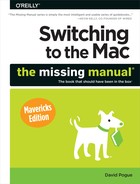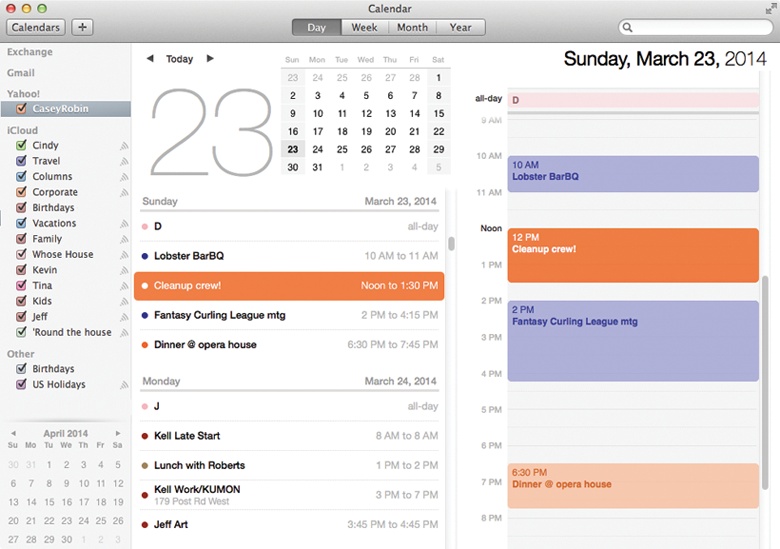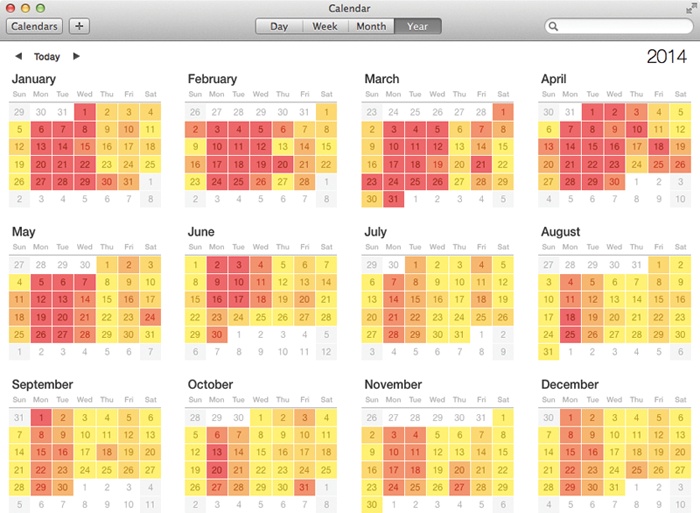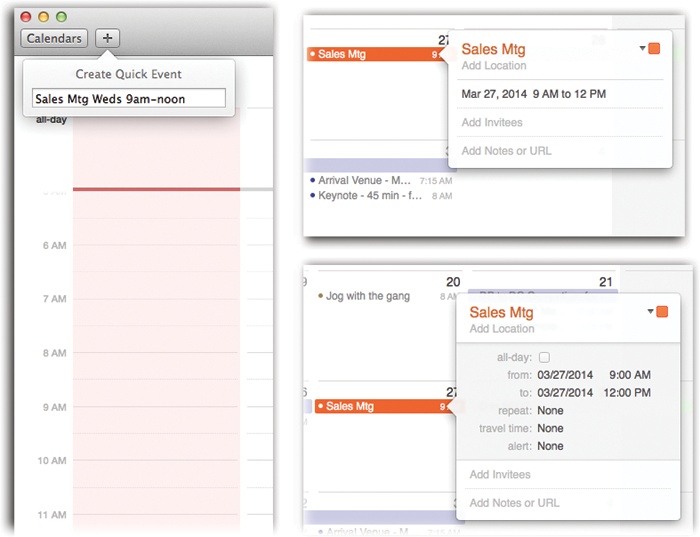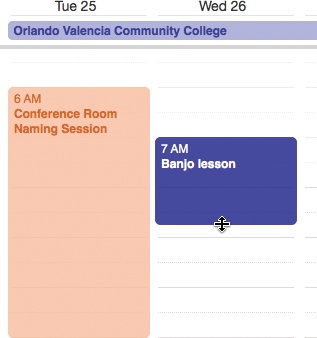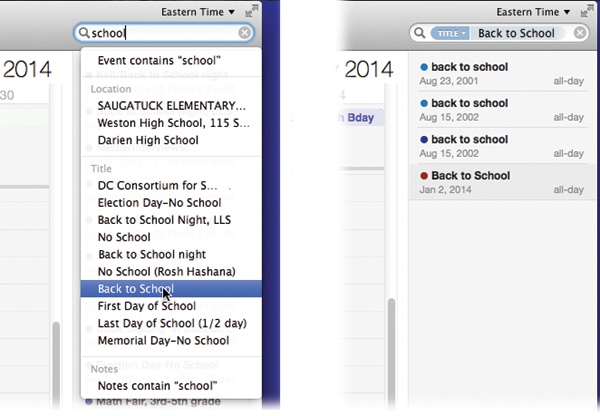The calendar program that was called iCal for many years is now called Calendar, so that it matches up better with the iPhone and iPad.
Calendar is not so different from those “Hunks of the Midwest Police Stations” paper calendars that people leave hanging on the walls for months past their natural life span.
For example, Calendar still offers several advantages over paper calendars:
It can automate the process of entering repeating events, such as weekly staff meetings or gym workouts.
Calendar can give you a gentle nudge (with a sound, a dialog box, or even an email) when an important appointment is approaching.
Calendar can share information with Contacts, with Mail, with your iPod/iPad/iPhone, with other Macs, or with “published” calendars on the Internet. Some of these features require one of those iCloud accounts described in Chapter 10. But Calendar also works fine on a single Mac, even without an Internet connection.
Calendar can subscribe to other people’s calendars. For example, you can subscribe to your spouse’s calendar, thereby finding out when you’ve been committed to after-dinner drinks on the night of the big game on TV. You can also tell Calendar to display your online calendars from Google and Yahoo, or even your company’s Exchange calendar (Chapter 8).
When you open Calendar, you see something like Figure 18-2. By clicking one of the View buttons above the calendar, or by pressing ⌘-1, ⌘-2, ⌘-3, or ⌘-4, you can switch among these views:
Day looks exactly like a day-at-a-time desk calendar. On the right-side “page,” you see today’s schedule on an hour-by-hour chart. On the left “page,” you get a simple list of appointments for today and the next few days.
If you choose Calendar→Preferences, you can specify what hours constitute a workday. This is ideal both for those annoying power-life people who get up at 5 a.m. for two hours of calisthenics and for the more reasonable people who sleep until 11 a.m.
Week fills the main display area with seven columns, reflecting the current week. (You can establish a five-day workweek instead in Calendar→Preferences.)
Figure 18-2. In Calendar, the
 and
and  buttons at top left take you to the previous or next day, week, month, or year (depending on your current view). In the Day view, shown here, you can click the tiny numbers on the mini-calendars to change days. Double-click any appointment to open its Info balloon, shown in Figure 18-4.
buttons at top left take you to the previous or next day, week, month, or year (depending on your current view). In the Day view, shown here, you can click the tiny numbers on the mini-calendars to change days. Double-click any appointment to open its Info balloon, shown in Figure 18-4.Month shows the entire current month; a thicker gray line identifies the current week to help you get your bearings. The time of each appointment is listed in gray off to the right of each square. Double-click a date number to open the Day view for that date.
If a Month-view square is too small to show everything you’ve got scheduled that day, you’ll see a notation at the bottom of the square like, “3 more…” Sometimes, making the window bigger (or full screen) helps make more room, or you can just double-click the date’s number to switch to Day view and see everything at once.
Tip
If your mouse has a scroll wheel, you can use it to great advantage in Calendar. For example, when entering a date, turning the wheel lets you jump forward or backward in time. It also lets you change the priority level of a To Do item you’re entering, or even tweak the time zone as you’re setting it.
Year view displays a “heat map” of the entire year (Figure 18-3).
In any of the views, double-click an appointment to see more about it. The very first time you do that, you get the summary balloon shown at top right in Figure 18-4. If you want to make changes, you can then click the Edit button to open a more detailed view.
Tip
In Week or Day view, Calendar sprouts a handy horizontal line that shows where you are in time right now. (Look in the hours-of-the-day “ruler” down the left side of the window to see this line’s little red bulb.) A nice touch, and a handy visual aid that can tell you at a glance when you’re already late for something.
Figure 18-3. Year view shows the entire year. The colors of the squares are a “heat map” that indicate how hectic your schedule is. You see a range of shades from light yellow (not very busy) to deep red (you’re in big trouble). Double-click a date to open the Day view for that date.
Also in any view, you can switch into full-screen view by clicking the ![]() icon in the upper-right corner of the window. See Full Screen Mode for more on Full Screen mode.
icon in the upper-right corner of the window. See Full Screen Mode for more on Full Screen mode.
The basic Calendar is easy to figure out. After all, with the exception of one unfortunate Gregorian incident, we’ve been using calendars successfully for centuries.
Even so, there are two ways to record a new appointment: using the mouse, or using the new Quick Event box.
You can quickly record an appointment using any of several techniques, listed here in order of decreasing efficiency:
In Month view, double-click a blank spot on the date you want. Type the name of the event and a time slot—for example, Sales meeting 9am-4:30. (See The Quick Event way, below, for details on how Calendar interprets these time notations.)
In Day or Week view, double-click the starting time to create a one-hour appointment. Or drag vertically through the time slots that represent the appointment’s duration. Either way, type the event’s name inside the newly created colored box.
In any view, right-click (or two-finger click) a date and choose New Event from the shortcut menu. Type the event’s name.
Unless you use the drag-over-hours method, a new event believes itself to be one hour long. But in Day or Week view, you can adjust its duration by dragging the bottom edge vertically. Drag the dark top bar up or down to adjust the start time.
In many cases, that’s all there is to it. You’ve just specified the day, time, and title of the appointment. Now you can get on with your life.
In the Quick Event method, the program spares you the trouble of manually selecting dates, start times, and end times. Instead, the program understands notations like “7 pm Friday,” and puts your new appointment into the right time slot automatically.
Figure 18-4. Left: Type a plain-English shorthand for an appointment, like “Sales Mtg Weds 9am-noon.” Press Enter. Marvel as Calendar interprets the times you typed and inserts your meeting into the right time slot. Top right: All the details for an appointment appear right in this balloon/box. Click a detail, like the time, to expand the balloon so that you can edit it (bottom right).
To use this feature, press ⌘-N. (Or click ![]() —top left of the window—or choose File→New Event). The Quick Event box appears. Proceed as shown in Figure 18-4.
—top left of the window—or choose File→New Event). The Quick Event box appears. Proceed as shown in Figure 18-4.
Note
Calendar proposes adding the new appointment to your default calendar—that is, the category you use most often (read on for details on these calendar categories). Supposedly, you’ve already told it which category is your preferred one by using the Calendar→Preferences→General→Default Calendar pop-up menu.
But as you add a new appointment this way, you can override that setting by holding down the ![]() button. You get a pop-up menu of your calendar categories; only after you click the one you want do you see the Quick Event box shown in Figure 18-4.
button. You get a pop-up menu of your calendar categories; only after you click the one you want do you see the Quick Event box shown in Figure 18-4.
Into the Quick Event box, you’re supposed to type the name of your appointment and its date and time. For example, you could type Report deadline Aug 12, or “Titanic 2: The Return” Sat 7 pm, or Cara date 11-11:15am.
When you press Return, Calendar interprets what you typed, using these rules:
If you didn’t specify an ending time, Calendar sets the appointment to 1 hour long.
If you didn’t enter any time information, Calendar figures you meant an all-day event like a birthday, holiday, or deadline.
If you typed breakfast or morning, Calendar sets the appointment to start at 9 a.m.; lunch or noon, it starts at 12 p.m.; dinner or night, it starts at 8 p.m.
If you enter a weekday (for example, Chicago Monday), Calendar assumes you mean the very next occurrence of that day. (If that’s not what you want, enter the date, like Chicago Jul 3.)
If you enter a time but not a date or day (for example, Fishing 3:30 pm), Calendar assumes you mean today.
No matter which method you use to create the basic event (the mouse way or the Quick Event way), you’re now presented with the information balloon shown at right in Figure 18-4. Here’s where you go to town filling in the details. (This same balloon will appear when you double-click any existing appointment later.)
Tip
You can also open the Info balloon by clicking the appointment and then pressing ⌘-E (which is short for Edit→Edit Event).
Or you know what? You might prefer keeping a permanent floating Info bubble in one spot on your screen, rather than having to deal with a bubble that pops out of each appointment. Just choose View→Show Inspector. You can move the resulting editing panel anywhere on the screen and leave it there; it shows the details of any appointment you select.
For each appointment, you can Tab your way to the following information areas:
subject. That’s the large, bold type at the top—the name of your appointment. For example, you might type Fly to Phoenix.
calendar. A calendar, in Calendar’s terminology, is a subset—a category—into which you can place appointments. You can create one for you, one for family-only events, one for book-club appointments, and so on. You can hide and show these categories at will. Details begin on Printing events; for now, note that the tiny colored square in the top-right corner of the Info bubble is a pop-up menu of your calendars.
location. This field makes a lot of sense; if you think about it, almost everyone needs to record where a meeting is to take place. You might type a reminder for yourself like My place, a specific address like 212 East 23, or some other helpful information, like a contact phone number or flight number.
As you type, Calendar busily consults Apple’s worldwide database of street addresses—and proposes a few matches, as shown in Figure 18-5 (top left). You’re under no obligation to choose one of these; you can ignore the suggestions and type “Casey’s treehouse,” for all Apple cares. But if you do choose from Apple’s list of proposals, some cool things happen.
For example, you get a little map (which you can click to open the Maps app for a bigger view), as shown in Figure 18-5 (top right). You get to see the current weather, so you know how much to bundle up. And you get to use the travel-time feature described below.
all-day. An “all-day” event, of course, refers to something that has no specific time of day associated with it: a holiday, a birthday, a book deadline. When you turn on this box, you see the name of the appointment jump to the top of the Calendar screen, in the area reserved for this kind of thing.
from, to. You can adjust the times shown here by typing, clicking buttons, or both. Press Tab to jump from one setting to another, and from there to the hours and minutes of the starting time.
Note
The little calendar that pops up when you click the date is handier than typing a date manually.
For example, start by clicking the hour, and then increase or decrease this number either by pressing
 and
and  or by typing a number. Press Tab to highlight the minutes and repeat the arrow-buttons-or-keys business. Finally, press Tab to highlight the AM/PM indicator, and type either A or P—or press
or by typing a number. Press Tab to highlight the minutes and repeat the arrow-buttons-or-keys business. Finally, press Tab to highlight the AM/PM indicator, and type either A or P—or press  or
or  —to change it, if necessary.
—to change it, if necessary.Figure 18-5. Here’s the life cycle of OS X’s location and travel-time feature. Top left: To make the travel-time calculation work, you must choose from Calendar’s list of location suggestions, based on what you’ve typed. Top right: You get a map and weather report for that location. Bottom left: Calendar knows how long it will take to get there… Bottom right: … and will remind you when it’s time to get going!
time zone. This option appears only after you choose Calendar→Preferences→Advanced and then turn on “Turn on time zone support.” And you would do that only if you plan to be traveling on the day this appointment comes to pass.
Once you’ve done that, a time zone pop-up menu appears. It starts out with “America/New York” (or whatever your Mac’s usual time zone is); if you choose Other, a tiny world map appears. Click the time zone that represents where you’ll be when this appointment comes due. From the shortcut menu, choose the major city that’s in the same zone you’ll be in.
Tip
The time zone pop-up menu remembers each new city you select. The next time you travel to a city you’ve visited before, you won’t have to do that clicking-the-world-map business.
Now, when you arrive in the distant city, use the time zone pop-up menu at the top-right corner of the Calendar window to tell Calendar where you are. You’ll see all of Calendar’s appointments jump, like magic, to their correct new time slots.
repeat. The pop-up menu here contains common options for recurring events: every day, every week, and so on. It starts out saying None.
Once you’ve made a selection, you get an end pop-up menu that lets you specify when this event should stop repeating. If you choose “Never,” you’re stuck seeing this event repeating on your calendar until the end of time (a good choice for recording, say, your anniversary, especially if your spouse might be consulting the same calendar). You can also turn on “After (a certain number of times),” which is a useful option for car and mortgage payments. And if you choose “On date,” you can specify the date when the repetitions come to an end; use this option to indicate the last day of school, for example.
“Custom” lets you specify repeat schedules like “First Monday of the month” or “Every two weeks.”
travel time. This item automatically builds travel time into Calendar’s understanding of any appointment. After all, it’s not very useful to get a reminder like “Lunch with Jenkins at 1 p.m.” 10 minutes beforehand if it takes half an hour to get there.
Now, then: If Calendar is to calculate travel time, it has to know where you’re starting out and where you’re going.
To figure out your starting point, the Mac consults your “me” card in the Contacts app (Contacts (Address Book)), and uses either your home address or your work address, depending on the time of day. (How does Calendar know when you’re at work? It cleverly uses the “Day starts at” and “Day ends at” settings in Calendar→Preferences→General.)
If you haven’t specified home and work addresses on your “me” card, then Calendar uses the current location of your Mac as the starting point. (And that works only if you’ve allowed the Mac to track your location by turning on Location Services in System Preferences→Security & Privacy→Privacy.)
For the arrival location, the Travel Time feature requires that you’ve accepted one of the Mac’s address suggestions, as described above (Figure 18-5, top left).
Once all that’s done, the “travel time” pop-up menu shows you both the driving and walking times to your appointment. You can override these suggestions if you like; you can choose any time interval from 5 minutes to 2 hours, or choose Custom to plug in something not listed here.
The real payoff, of course, comes when you set a reminder for yourself; read on.
alert. This pop-up menu tells Calendar how to notify you when a certain appointment is about to begin. Calendar can send four kinds of flags to get your attention. It can display a message (with a sound, if you like), send you an email, run an AppleScript, or open a file on your hard drive. (You could use this unusual option to ensure that you don’t forget a work deadline by having Calendar fling the relevant document open in front of your face at the eleventh hour.)
Once you’ve specified an alarm type, a new pop-up menu appears to let you specify how much advance notice you want for this particular appointment. If it’s a TV show, a reminder 5 minutes before airtime is fine. If it’s a birthday, you might set up a two-day warning, so there’s time to buy a present.
And if you’ve used the travel-time feature described above, you can even choose “When I need to leave” (Figure 18-5, lower right), which factors travel time into the reminder. (Alas, the Mac does not factor in traffic conditions.)
show as (busy/free/tentative/out of office). This little item shows up only if you’ve subscribed to a calendar server, like an Internet-based calendar (in geek-speak, a CalDAV server) or your company’s Exchange calendar (Chapter 8). It communicates to your colleagues when you might be available for meetings.
Note
If your calendar comes from a CalDAV server, then your only options are “busy” and “free.” The factory setting for most appointments is “busy,” but for all-day events it’s “free.” Which is logical; just because it’s International Gecko Appreciation Day doesn’t mean you’re not available for meetings (rats!).
You might think: “Well, duh—if I’ve got something on the calendar, then I’m obviously busy!” But not necessarily. Some Calendar entries might just be placeholders, reminders to self, TV shows you wanted to watch, appointments you’d be willing to change—not things that would necessarily render you unavailable if a better invitation should come along.
invitees. If the appointment is a meeting or some other gathering, you can type the participants’ names here. If a name is already in your Contacts program, Calendar proposes autocompleting the name for you.
If you separate several names with commas, Calendar automatically turns each into a shaded oval button. You can click it for a pop-up menu of commands like Remove Attendee and Send Email. (That last option appears only if the person in Contacts has an email address, or if you typed a name with an email address in brackets, like this: Chris Smith <[email protected]>.)
Tip
If you and your invitees are on the same CalDAV or Exchange calendar service—usually, this means coworkers at the same company—Calendar can show a “time map” of the invitees’ days, all in a handy scrolling window, so you can find a time when everybody’s free. To see this map, click the Available Meeting Times link beneath the addresses of the invitees you’ve specified, or choose Window→Availability Panel (see Figure 18-6).
Once you’ve specified some attendees, a Send button appears in the Info box. If you click it, Calendar fires up Mail and prepares ready-to-send messages, each with an iCal .ics attachment: a calendar-program invitation file. See the box below.
url. A URL is a Uniform Resource Locator, better known as a Web address, like www.apple.com. If there’s a URL relevant to this appointment, by all means type it here. Type more than one, if it’ll help you; just be sure to separate them all with commas.
note. Here’s your chance to customize your calendar event. You can type, paste, or drag any text you like in the note area—driving directions, contact phone numbers, a call history, or whatever.
Your newly scheduled event now shows up on the calendar, complete with the color coding that corresponds to the calendar category you’ve assigned.
Once you’ve entrusted your agenda to Calendar, you can start putting it to work. Calendar is only too pleased to remind you (via pop-up messages) of your events, reschedule them, print them out, and so on. Here are a few of the possibilities.
To edit a calendar event’s details, click to open its Info balloon (Figure 18-4).
And if you want to change only an appointment’s “calendar” category, right-click (or two-finger click) anywhere on the appointment and choose from the resulting Calendar shortcut menu. That way, you bypass the need to open the Info balloon.
If an event in your life gets rescheduled, you can drag an appointment block vertically in a Day- or Week-view column to make it later or earlier the same day, or horizontally to another date in any view. (If you reschedule a recurring event, Calendar asks if you want to change only this occurrence, or this and all future ones.)
If something is postponed for, say, a month or two, you’re in trouble, since you can’t drag an appointment beyond its month window. You have no choice but to open the Info balloon and edit the starting and ending dates or times—or just cut and paste the event to a different date.
If a scheduled meeting becomes shorter or your lunch hour becomes a lunch hour-and-a-half (in your dreams), changing the length of the representative calendar event is as easy as dragging the bottom border of its block in any column view (see Figure 18-7).
To commit your calendar to paper, choose File→Print, or press ⌘-P. The resulting Print dialog box lets you include only a certain range of dates, only events on certain calendars, with or without To Do lists or mini-month calendars, and so on.
You should recognize the oval text box at the top of the Calendar screen immediately: It’s almost identical to the Spotlight box. This search box is designed to let you hide all appointments except those matching what you type into it. Figure 18-8 has the details.
Figure 18-8. Left: Type into the search box; Calendar sprouts a list of suggestions (“Event contains ‘school,’ “Notes contains ‘school,’” and so on). Right: Click one to create a search token exactly like the ones that Spotlight and Mail use. They let you build up complex searches, bubble by bubble. Double-click any row of the list to jump to the corresponding event on the calendar and open up its summary balloon.
Just as iTunes has playlists that let you organize songs into subsets and iPhoto has albums that let you organize photos into subsets, Calendar has calendars that let you organize appointments into subsets. They can be anything you like. One person might have calendars called Home, Work, and TV Reminders. Another might have Me, Spouse ’n’ Me, and Whole Family. A small business could have categories called Deductible Travel, R&D, and R&R.
And now, the Calendars Tip-O-Rama:
To create a calendar, choose File→New Calendar. You now have to specify where you want this category to live: On My Mac (meaning on your Mac), or on one of your online accounts, like iCloud, Google, Yahoo, or Exchange. Type a name that defines the category in your mind.
Note
Read this slowly: When you set up an iCloud account in System Preferences or when you first run Mavericks, Calendar automatically tranfsers your “On My Mac” categories to iCloud. You can no longer create categories that live only on your Mac. (There’s one exception: If you created your iCloud account in Calendar Preferences, then you can have an “On My Mac” category.)
To see your list of categories, click the Calendars button (upper left of the window). A sidebar list appears.
Hide or show an entire category of appointments at once by turning on or off the appropriate checkbox in the Calendars sidebar.
To change the color of a category, right-click (or two-finger click) its name in the sidebar list; from the shortcut menu, choose Get Info. The Calendar Info box appears. Here you can change the name, color, or description of this category—or turn off its alarms.
To specify your default calendar, choose Calendar→Preferences→General. Choose from the Default Calendar pop-up menu. (The Default calendar is the category that every new appointment falls into unless you change it. It’s also the category that other apps‚ like Mail, propose putting new appointments into.)
To assign a new appointment to a calendar, click the color swatch in the corner of its Info balloon.
To change an appointment’s calendar category, right-click (or two-finger click) the appointment’s name and choose a calendar name from the shortcut menu.
You may be able to make calendar groups, too. That’s a container that consolidates the appointments from several other calendars. For example, you could have a calendar group called Kids, containing the individual calendars for each of your offspring. Super-calendars like this make it easier to manage, hide, show, print, and search subsets of your appointments. (Sadly, this feature is available only for “On My Mac” categories, as described above—not for online accounts.)
To create a calendar group, choose File→New Calendar Group. Name the resulting item in the Calendar list; for the most part, it behaves like any other calendar. Drag other calendar names onto it to include them. Click the flippy triangle to hide or show the component calendars.
One of Calendar’s best features is its ability to post your calendar on the Web, so that other people can subscribe to it, which adds your appointments to their calendars. Anyone with a Web browser—or only people you designate—can also view your calendar, right online.
For example, you might use this feature to post the meeting schedule for a club that you manage, or to share the agenda for a series of upcoming financial meetings that all your coworkers will need to consult.
The steps for sharing a calendar depend on whether or not you have an iCloud account. Voilà.
If you and your buddy both have iCloud accounts: See Figure 18-9 for step-by-steps. Note that you can specify whether each person can just see the appointments, or be able to edit them, too. That’s a delightful, two-way collaboration—a terrific way for a couple or a family to coordinate everyone’s calendars, for example.
Figure 18-9. Top: Point to the name of the iCloud calendar you want to publish; click the “shared” icon (![]() ) that appears next to its name. In this pop-out panel, enter the email address of the lucky recipient (use the Mac’s suggestions from your Contacts to help you). You can invite multiple people; just keep tying addresses. The Public Calendar option means that the whole Internet can see this calendar category (if they know the secret URL). Click Done. Bottom: After the recipient has accepted the invitation, click the
) that appears next to its name. In this pop-out panel, enter the email address of the lucky recipient (use the Mac’s suggestions from your Contacts to help you). You can invite multiple people; just keep tying addresses. The Public Calendar option means that the whole Internet can see this calendar category (if they know the secret URL). Click Done. Bottom: After the recipient has accepted the invitation, click the ![]() icon again; this time, a green checkmark appears next to the person’s name. Use the
icon again; this time, a green checkmark appears next to the person’s name. Use the ![]() to specify whether this person can see your appointments (View Only) or make changes to them, too (View & Edit).
to specify whether this person can see your appointments (View Only) or make changes to them, too (View & Edit).
Behind the scenes, Calendar sends an invitation to the recipient. She’ll see a notification on her Mac (in Calendar or iCal), iPhone or iPad, at iCloud.com, and in her copy of Microsoft Outlook. It probably looks something like this: ![]() . Once she clicks it, clicks the invitation and clicks Accept, your shared calendar shows up on her machine.
. Once she clicks it, clicks the invitation and clicks Accept, your shared calendar shows up on her machine.
Later, you can modify the settings (Figure 18-9, bottom). Or you can stop sharing by clicking the calendar name and then choosing Edit→Stop Sharing.
Tip
You can also share an iCloud calendar at icloud.com. Just click the ![]() icon beside a calendar’s name.
icon beside a calendar’s name.
If you don’t have iCloud: If you don’t have an iCloud account, then you’ll need a Web site of your own, where your online calendar can be hung. And it has to be a WebDAV-compatible server (ask your Web-hosting company). You know what? It might just be easier to sign up for a free iCloud account and do it that way.
In any case, begin by making sure that the Calendars list is open. Click the calendar you want to share. Choose Edit→Publish Calendar.
Tip
You have to perform this step individually for each calendar category. If you want to publish more than one calendar simultaneously, then create a calendar group, and publish that.
A dialog box appears. This is where you specify your Web address, its password (if necessary), and how your saved calendar is going to look and work. If you turn on “Publish changes automatically,” then whenever you edit the calendar, Calendar connects to the Internet and updates the copy there. (Otherwise, you can right-click the calendar’s name and choose Refresh whenever you want to update the Web copy.)
When you click Publish, your Mac connects to the Web and then shows you the Web address (the URL) of the finished page, complete with a Send Mail button that lets you fire the URL off to your colleagues.
Tip
Whenever you want to send someone the subscription information, click the calendar category you’ve published and choose Edit→Send Publication Email. Calendar will prepare an outgoing email message containing details on subscribing to your calendar.
To stop publishing that calendar, click its name in the Calendars pop-up list and then choose Edit→Stop Publishing.
If somebody else has published a calendar, you can subscribe to it by choosing File→New Calendar Subscription. In the Subscribe to Calendar dialog box, type in the Internet address you received from the person who published the calendar.
You can also provide your own name for this category, specify how often you want your own copy to be updated (assuming you have a full-time Internet connection), and indicate whether or not you want to be bothered with the publisher’s alarms and notes.
When it’s all over, you see a new “calendar” category in your left-side list, representing the published appointments.
Tip
Want to try it out right now? Visit www.icalshare.com, a worldwide clearinghouse for sets of Calendar appointments. You can subscribe to calendars for shuttle launches, Mac trade shows, National Hockey League games, NASCAR races, soccer matches, the Iron Chef and Survivor TV shows, holidays, and much more. You’ll never suffer from empty-calendar syndrome again.
If you maintain a calendar online—at Google, Yahoo, or Facebook, for example—you may take particular pleasure in discovering how easy it is to bring those appointments into Calendar. It’s one handy way to keep, for example, a husband’s and wife’s appointments visible on each other’s calendars.
Setting this up is ridiculously easy. Choose Calendar→Preferences→Accounts. Click the ![]() button below the list. Enter your Google, Yahoo, or Facebook address (for example, [email protected]) and password. Click Create.
button below the list. Enter your Google, Yahoo, or Facebook address (for example, [email protected]) and password. Click Create.
In a minute or so, you’ll see all your Google, Yahoo, or Facebook events show up in Calendar. (Each Web calendar has its own heading in the left-side list.) Better yet: It’s a two-way sync; changes you make to these events in Calendar show up on the Web, too.
Here’s the real magic of Calendar, iCloud, and the rest of Apple’s software archipelago: Your calendar can be autosynced among all your machines, like your iPhone, iPad, and Macs. Add an appointment on your phone, change an appointment on your iPad, whatever—all your other gadgets are wirelessly and automatically synced to match. See Chapter 10 for details on this amazing setup.
